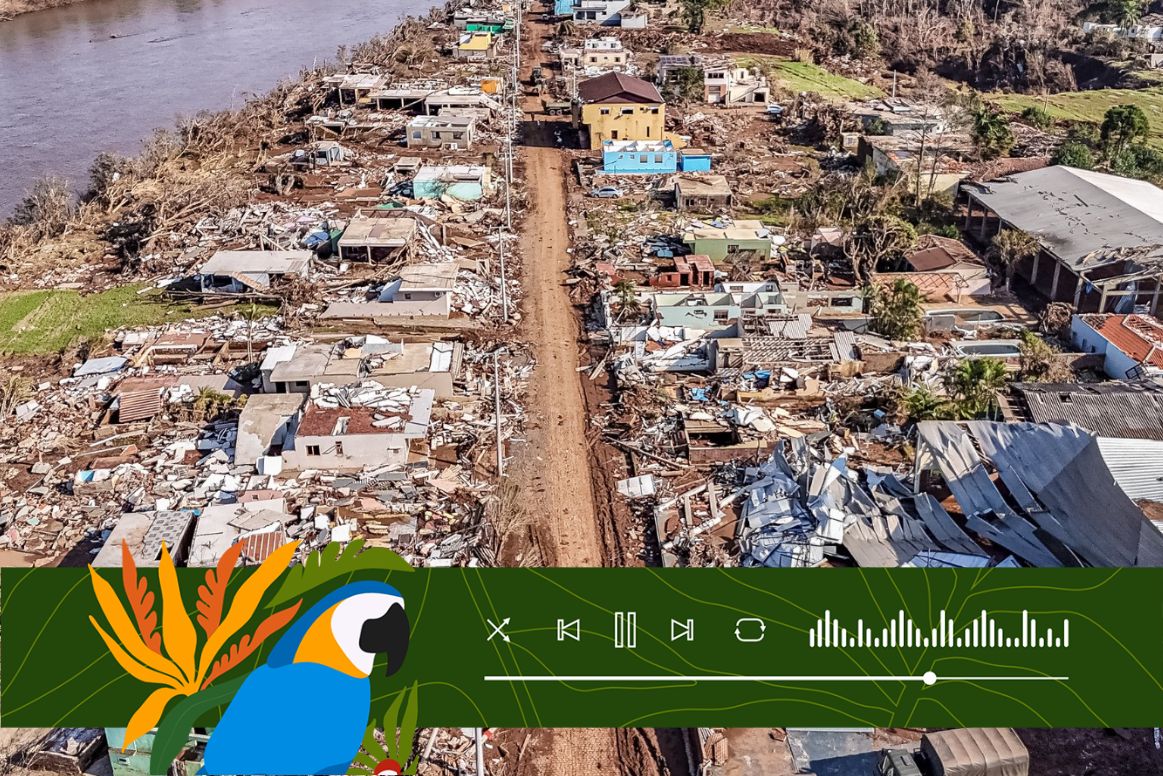COP30 Brasil Bulletin #01 - Special Report | Floodings in the Brazilian state of Rio Grande do Sul lay bare the climate crisis
A year ago, heavy rain caused the greatest flood in the South of Brasil, affecting 2.3 million people. Combining climate change, irregular occupation, and inappropriate infrastructure, the 2024 floods warn about the urgency for prompt global action. Pundits point COP30 as an essential space of debate for pointing solutions and avoiding new disasters. They warn that reconstruction demands radical change. Listen to the special report and get to know more.

Report by Leandro Molina / leandro.molina@presidencia.gov.br
Speaker: Inez Mustafa / inez.mustafa@presidencia.gov.br
Reporter: Exactly one year ago, the Brazilian state of Rio Grande do Sul went through days that would change forever its history. The rains that began at the end of April 2024 transformed in a few days into the greatest climate disaster ever registered in the state. After eight days of intense rain, the setting was devastating: entire cities were submersed, highways became rivers, communities were isolated, and a number of dead and missing people that would only increase with every update from the Civil Defence. After twelve months, while many families are working to rebuild their lives, specialists warn that the disaster was much more than a mere isolated climatic event. The flooding in southern Brasil was a cruel portrait of the climate emergency that the planet is going through, and a warning of what may lay ahead if we don’t act now.
The first rain showers came on April twenty-seventh, but, at the beginning of May, the situation went completely out of control. Since the river basins are interconnected, the water excess of several rivers and affluents flowed into the Guaíba lake, in the city of Porto Alegre. In the capital of Rio Grande do Sul, this lake reached five point thirty-seven meters, flooding entire neighbourhoods and surpassing the historical mark of four point seventy-five meters registered in 1941. The climatologist, Francisco Aquino, from the Federal University of Rio Grande do Sul (UFRGS), does not doubt that this was the greatest flood disaster in Brazilian history.
Francisco Aquino: He stated that the combination of flying rivers coming from the Amazon at a thousand five hundred meters high and more intense atmospheric circulation upon Rio Grande do Sul, persistently induced the formation of storm clouds. During several days, the cluster of these clouds dumped, let's put it this way, between six hundred thirty and seven hundred millimetres of rain in less than four days. This volume represents over a third of the annual rain over Rio Grande do Sul. So, there is no further doubt that this event was caused by climate change.
Reporter: The flood inundated several cities in the Porto Alegre metropolitan region, such as South Eldorado, Canoas, Nova Santa Rita, and São Leopoldo, where the waters rose rapidly, flooding streets and houses. Families were pulled from the rooftops by Civil Defence’s helicopters and boats. On social media, the images of people and animals being rescued in boats and elderly people being carried on the backs of soldiers from the national force spread around the world. In the Taquari Valley, one of the most affected places by the flood, the river that gives its name to the region rose over thirty meters high with a frightening velocity, swallowing and dragging cities in minutes. The numbers reveal the tragedy’s dimension: one hundred eighty-four deaths, twenty-five missing, four hundred seventy-eight municipalities affected, approximately two thousand four hundred houses destroyed, over eighty-one thousand homeless, and around two point three million people affected directly or indirectly by the floods, according to the Civil Defence’s state data.
Roseli Pereira Dias, resident of Canoas, had never imagined the reality she would go through. In May, the rivers that devastated Rio Grande do Sul invaded her house, in the Rio Branco neighbourhood, in Canoas, leaving deep marks – both physical and emotional.
Roseli Pereira Dias: She shared that it was a very intense, exhausting, and wearing work, physically and emotionally. Taking away all these things from inside her mother’s house, because it was the house where she was born, where she grew up. It was very wearing, as it was for everybody; she was no exception.
Reporter: With the water rising rapidly, Roseli and her husband abandoned the house, taking their two dogs with them. When they returned, they found not only mud but also contamination from industrial oil casks of a nearby recycler, which spread through the neighbourhood. Furniture, photos, and books turned into piles of rubble in the Eduardo Gomes Park – which became a deposit of destroyed memories.
Roseli Pereira Dias: She said that little by little, they saw a street transformed into a war zone, because everybody was making the same things, those rubble mountains. In their home, the water reached almost two meters high. They restructured their home in an unsafe way, because they feel insecure. So, they did not buy a spring bed anymore, instead, they made an iron bed, a structure of iron to put the sink above, they put boars underneath it, and a few curtains, and that was it. They do not even have a couch in the living room.
Reporter: To mark one year since the disaster, Roseli and other residents of six neighbourhoods from Canoas organized an act in one of the city parks, where piles of rubble symbolized their losses. Roseli believes that the flood was no accident, but a result of climate change, and that COP30, which will take place in Brasil, must provide the solutions for the climate crisis in the world.
Roseli Pereira Dias: She expressed that, personally, she believes in the importance of events like this, because the debate has to take place, and we have to expand it as much as possible. so people can participate in these reflections; but she thinks that this is a debate that we have to make increasingly reach the grassroots of society.
Reporter: Marcelo Dutra da Silva, professor of Ecology at the Federal University of Rio Grande (FURG), highlights that the torrential rain of May 2024, driven by an extreme El Niño, contributed to the trail of destruction. For the professor, a specialist in ecology and climate change, the disaster is an outcome of decades of mistakes in land use, coupled with the global climate emergency.
Marcelo Dutra da Silva: He stresses that the great question is that we are living in a completely new reality. Climate has changed and is different, the planet Earth is one point forty-eight degrees hotter. It changed the pattern of rains and winds, and it also has changed the pattern of other events connected to hail, for example. So, we are going through something that is very different, but we are completely responsible for.
Reporter: Marcelo Dutra draws a striking overview: while public authorities in the state were relaxing environmental laws and urban occupation was advancing over risk areas, science was already warning of the effects of a warmer planet.
Marcelo Dutra da Silva: He affirmed that climate change is global. And this new normal means that we need to adapt. What we saw happening in Porto Alegre is a sum of causes that fostered that devastating event. Associated with it, is the fact that our absolute negligence and complete lack of attention to the risks, changing significantly the landscape, sometimes not paying attention to the legislation, sometimes changing the legislation.
Reporter: Professor Marcelo Dutra also reiterates that COP30 will be a vital place to debate global solutions for climate change.
Marcelo Dutra da Silva: He highlights that this for Brasil, as an international actor, is absolutely important. The knowledge reaching people in fact is very important, so the next events that will come, they arrive with us being better prepared, with more guarantee for us that we will not lose as much as we already lost before.
Reporter: Kelvin Simonis, owner of a sawmill in the industrial district of Encatando in the Taquari Valley, has never imagined that he would see his enterprise submerged under two meters of water. The floods devastated machinery, stocks, and part of the business’s infrastructure, causing a lot of damage.
Kelvin Simonis: He shared that they assessed a loss of two million reais in infrastructure, there was also a stock loss. Over two meters of water in the company caused a lot of destruction. They looked out of the window of the house, it was a sea of water. At first, they did not even know how to go on, but slowly they fixed the machinery, got the lines working, and started again.
Reporter: Kelvin says that help came in the form of credit lines from the Federal Government, which he says it is essential for getting the business back on his feet. He advises that the local population cannot give up, but to be aware that the climate crisis is real.
Kelvin Simonis: He stresses that our understanding is of the climate issue. They already had a history of floods. It was common in the region to have one flood per year, one every two years; but at much lower levels, striking only small parts. Also, the municipalities were already prepared for dealing with this flood level. Particularly, He doesn’t believe that this is an isolated episode.
Reporter: Pundits defend that, beyond rebuilding what was destroyed, the creation of a new model of development for the cities needs to be different, taking into account the climate reality of the twenty-first century. The geologist, Rualdo Menegat, from the Federal University of Rio Grande do Sul (UFRGS), is emphatic when talking about the impact of the floods in the state.
Rualdo Menegat: He adds that we are, indeed, living a climate emergency. First, there was a total removal of the soil in many circumstances in the Plateau region. An intense erosion of the soil. Another really impressive element was all this flood, which flowed through the deep valleys of Rio Grande do Sul, so there was a landslide, where we counted more than seventeen thousand scars. Over there, those waters gained intensity because of debris, so the water was really heavy, with earth, sand, stones. So, these heavy waters, in this case, in this event, part of the cities are simply destroyed. There were no houses anymore.
Reporter: Concerning the Climate Conference, he says that COP30 has huge challenges ahead.
Rualdo Menegat: He sees COP30 as truly a great opportunity since it has a sensible government in Brasil, but it needs to give this leap forward of addressing society a stronger message. For that, it has a great ally, which is knowledge, which is provided by the universities.
Reporter: The public power's immediate action after the historical floods in Rio Grande do Sul avoided a humanitarian crisis and guaranteed the recovery of this state’s economy. The case highlights the governmental agility in climate emergencies. The priceless loss demanded an urgent response. The record rainfall, plus the periods of drought in southern Brasil, make it clear that the climate emergency is not a distant threat, but an urgent reality. For specialists, COP30, which will take place in Brasil, is defined by a vital space to debate global solutions, reinforcing the need for effective policies against climate change.
The tragedy in Rio Grande do Sul completed a year, but its lessons remain. For the people from Rio Grande do Sul, May 2024 was not only a month of rain and floods – but also a landmark in the climate crisis that demands immediate global actions and that the world can no longer ignore.
